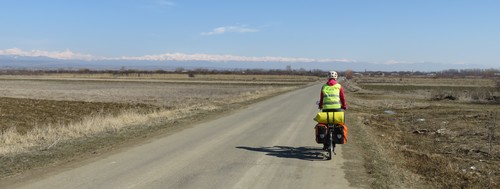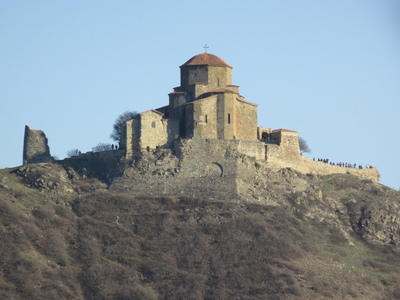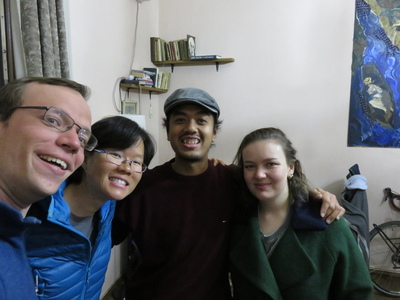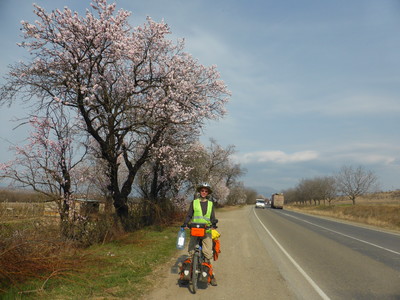Spring has sprung in Iberia
Posted on 2019-03-19
From the Rikoti pass, we rolled down to Khashuri, where we camped for the first time in Georgia. With the skies finally clear after a week of rain, we were blessed with views of the Greater Caucasus mountains from where we camped!
Our frozen tent with the Greater Caucasus mountains in the background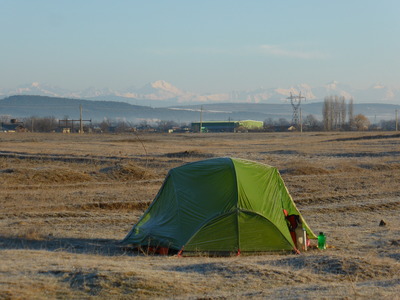
Up to this point, we had been more or less following the main highway through Georgia, the road that connects the Turkish coast to Azerbaijan, Armenia, and beyond. This road was distinctly unpleasant to cycle on, full of long-distance trucks and crazy Georgian drivers (we really don't want to harp on this, but we have not been to any other country where so many cars are driving around with dents and missing bumpers), but we could not find any good alternatives. However, after Khashuri, we were able to follow a secondary road almost all the way to Tbilisi, and this road was a real pleasure to cycle on, with little traffic and amazing landscapes.
We took a rest day in Gori, the hometown of Stalin, but it was not Stalin that we went to see (there is a museum dedicated to their hometown "hero" there). Instead, we went to explore Uplistsikhe, an ancient cave town about 10km from Gori. One of the oldest settlements in the Caucasus region, the town contains structures from the Early Iron Age to the Late Middle Ages. We were impressed by the size and detail of some of the rooms that had been cut into the rocks by hand so long ago and still stand today.
"Hall with a single column" in Uplistsikhe
We then headed to Mtskheta, one of the oldest cities in Georgia and the former capital of the ancient Kingdom of Iberia, an area roughly corresponding to eastern Georgia today. Mtskheta was also where St. Nino, a female evangelist from Cappadocia, started her missionary work that resulted in the Christianisation of Iberia in the early 4th century, making it the second state in the world to officially embrace this new religion (after Armenia). Some of the most important monuments of Georgian Orthodox Christanity are located in Mtskheta, including the Svetitskhoveli Cathedral and Jvari Monastery.
From Mtskheta, it was then just a short hop to the capital Tbilisi. We had to spend a few days in the city to apply for our Iranian visas, and we took the time to explore the city with another free tour, and fix some of our gear. We were looking for odds and ends, and were told to go to the markets next to Station Square. We have been to other big markets, but we don't think we have ever seen such an agglomeration of markets before, selling everything you might ever need, above and underground, with corridors leading down rabbit holes selling even more things. We left with a "haul" of two wide-brimmed hats (to make cycling brims), a repaired rear light, a nut and bolt, and a big bag of grains and fresh vegetables.
The markets next to Station Square in Tbilisi are massive, and sell everything you might ever need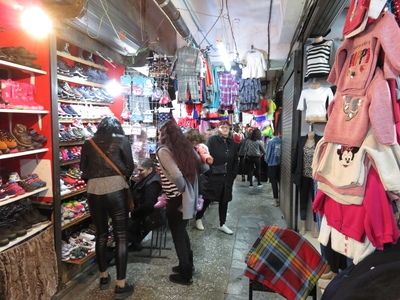
We also found out that there is quite a community of travellers "stuck" in Tbilisi, including many cyclists who were passing through Tbilisi on their way to somewhere else and ended up staying for a few months, mostly overwintering, but also for other reasons. The easy entry and work regulations (citizens of many countries can enter visa-free for a year, and are allowed to work) makes Georgia an easy place to take a long break from a long trip, but we resisted the temptation...
From Tbilisi, it took us just another three days to the border. We passed through Sighnaghi, a picturesque hilltop town (and a popular place for locals to get married), and Lagodekhi, a town at the foot of the Greater Caucasus mountains, from where we would continue along the foothills into Azerbaijan. Along the way, the weather was noticeably warmer and we noticed that many trees had started to blossom. Spring has sprung!
